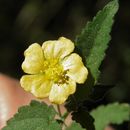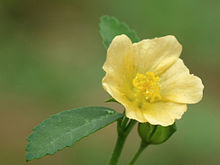en
names in breadcrumbs


Sinai.
Pantropical Weed.
Sida rhombifolia is the type species of the genus Sida. The taxonomy of this species/species complex is controversial and is discussed by Verdcourt (Kew Bull. 59: 233-239. 2005). The lectotype of S. rhombifolia almost certainly came from Jamaica, not India as suggested by some authors, and is a match with neither African nor Asian material. Verdcourt recognized six varieties for East African material, differing most obviously in mericarp morphology: most notably the degree of dehiscence, which varies from completely indehiscent to dehiscing by an apical slit to breaking into two valves, the degree of sculpturing, and the presence or not of awns. Chinese material appears to have a comparable range of variation, though many collections lack fully mature mericarps, and more detailed studies could lead to the recognition of more, comparable taxa.
Hu (Fl. China, Malvaceae [Fam. 153], 20-21. 1955) recognized two varieties, var. rhombifolia and var. corynocarpa (Wallich ex Masters) S. Y. Hu (Fl. China, Malvaceae [Fam. 153], 20. 1955), differing only in minor quantitative characters. The validity of var. corynocarpa is open to question, as Masters (Fl. Brit. India 1: 324. 1874) only mentioned the supposed basionym "Sida corynocarpa" in a note under S. rhombifolia var. retusa and therefore cannot be said to have accepted it as a species. Plants with prostrate stems from Taiwan, Japan (Ryukyu Islands), and the Philippines have been placed in S. rhombifolia subsp. insularis. Their status needs more detailed investigation. Borssum Waalkes included S. alnifolia Linnaeus within S. rhombifolia as var. retusa.
Hu 12784, from Hong Kong, has 10 indehiscent mericarps per flower, each with a single awn, suggesting a relationship to Sida rhombifolia var. maderensis (Lowe) Lowe (S. maderensis Lowe; S. unicornis Marais). That taxon has rather more strongly sculptured mericarps than Hu 12784, which might represent a distinct taxon.
Sida rhombifolia, commonly known as arrowleaf sida,[1] is a perennial or sometimes annual plant in the Family Malvaceae, native to the Old World tropics and subtropics. Other common names include rhombus-leaved sida, Paddy's lucerne, jelly leaf, and also somewhat confusingly as Cuban jute,[2] Queensland-hemp,[3] and Indian hemp (although S. rhombifolia is not closely related to either jute or hemp). Synonyms include Malva rhombifolia. It is used in Ayurvedic medicine, where it is known as kurumthotti.
The stems are erect to sprawling and branched, growing 50 to 120 centimeters in height, with the lower sections being woody. The dark green, diamond-shaped leaves are arranged alternately along the stem, 4 to 8 centimeters long, with petioles that are less than a third of the length of the leaves. The leaves are paler below, with short, grayish hairs. The apical half of the leaves have toothed or serrated margins while the remainder of the leaves are entire (untoothed). The petioles have small spiny stipules at their bases.
The moderately delicate flowers occur singly on flower stalks that arise from the area between the stems and leaf petioles. They consist of five petals that are 4 to 8 millimeters long, creamy to orange-yellow in color, and may be somewhat reddish in the center. Each of the five overlapping petals is asymmetric, having a long lobe on one side. The stamens unite in a short column. The fruit is a ribbed capsule, which breaks up into 8 to 10 segments. The plant blooms throughout the year.
It is widely distributed as a tropical and subtropical weed in the eastern and western hemispheres. This species is usually confined to waste ground, such as roadsides and rocky areas, stock camps or rabbit warrens, but can be competitive in pasture, because of its unpalatability to livestock. It grows on savannahs, roadsides, thick scrub, hillsides, and swampy woodlands. It is such a tropical species that it is located below 2,000 meters above sea level.

The plant is emollient and is for ulcers, high fevers and is antidiarrheal. It is useful against heart conditions such as pulmonary catarrh and ovarian diseases. Its root is used as an anticrotalic, a serum is prepared against the venom of rattlesnakes and black widow spiders. In Jalapa (Mexico) it is used a substitute drug for marijuana. In Alor, Eastern Indonesia the leaves are used to treat boils, and the root is used to treat infant asthma.[4]: 56
From the International Institute of Tropical Forestry, a division of the United States Department of Agriculture Forest Service:
Arrowleaf sida stems are used as rough cordage, sacking, and for making brooms. The stems have a high quality fiber and were once exported from India and elsewhere as “hemp” (Guzmán 1975, Holm and others 1997). Chemical analysis revealed that the leaves contain respectable amounts of nutrients: 74,000 to 347,000 ppm protein, 94,000 to 475,000 ppm carbohydrates, 33,000 to 167,000 ppm fiber, 14,000 to 71,000 ppm fat, and 16,000 to 81,000 ppm ash. However, it was reported that the root contained 450 ppm alkaloids and the presence of ephedrine and saponin (Southwest School of Botanical Medicine 2002). Another source reports an alkaloid content in the root of 0.1 percent and the presence of choline, pseudoephedrine, beta-phenethylamine, vascin, hipaphorine and related indole alkaloids (Shaman Australis Ethnobotanicals 2002). Perhaps because of these chemicals, arrowleaf sida is unpalatable to cattle (Kuniata and Rapp 2001). Arrowleaf sida has significant medicinal applications for which it is cultivated throughout India. The pounded leaves are used to relieve swelling, the fruits are used to relieve headache, the mucilage is used as an emollient, and the root is used to treat rheumatism (Parrotta 2001). Australian Aborigines use the herb to treat diarrhoea. Leaves are smoked in Mexico and a tea is prepared in India for the stimulation it provides (Shaman Australis Ethnobotanicals 2002).[5]
Sida rhombifolia, commonly known as arrowleaf sida, is a perennial or sometimes annual plant in the Family Malvaceae, native to the Old World tropics and subtropics. Other common names include rhombus-leaved sida, Paddy's lucerne, jelly leaf, and also somewhat confusingly as Cuban jute, Queensland-hemp, and Indian hemp (although S. rhombifolia is not closely related to either jute or hemp). Synonyms include Malva rhombifolia. It is used in Ayurvedic medicine, where it is known as kurumthotti.